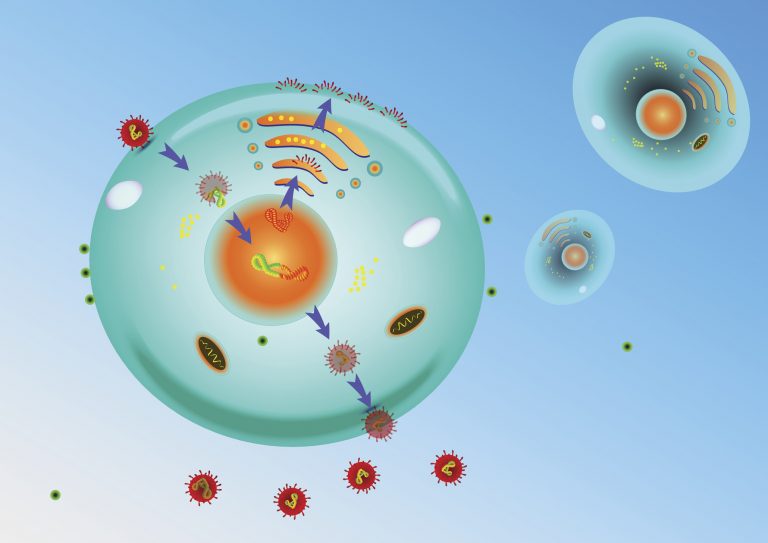
Viral replication is a complicated, and highly coordinated, process. Until now, available techniques could only provide a snapshot of the processes that happen inside cells to allow a virus to replicate. In other words, scientists could see the infected cells at a certain point in time, but it was not possible to monitor the process of virus infection from beginning to end. Now, researchers have developed an advanced technique that makes it possible to monitor a virus infection live. The technique, named VIRIM (virus infection real-time imaging), allows for the entire course of a virus infection to be visualized in the lab with great precision.
“This new method enables us to address many important questions about viruses,” said Sanne Boersma, PhD, a postdoctoral researcher in the Tanenbaum lab at Hubrecht Institute in the Netherlands, and the first author of the study.
The work is published in Cell, in a paper titled, “Translation and replication dynamics of single RNA viruses.”
RNA viruses, which have an RNA genome, represent a large group of viruses. Although RNA viruses have been studied extensively, little is known about the processes that occur during the first several hours of infection because of a lack of sensitive assays.
After infection of a host cell, an RNA virus hijacks many of the host cell’s functions and turns it into a virus-producing factory. This way, the intruder can quickly replicate inside cells in the body. The new virus particles are subsequently released through the respiratory tract and can infect other people. Examples of RNA viruses include coronaviruses, the hepatitis C virus, the zika virus, and enteroviruses—a group of viruses that include rhinoviruses, which cause the common cold, coxsackieviruses, that are an important cause of viral meningitis and encephalitis, and the poliovirus, that causes paralytic poliomyelitis.
The new technique named VIRIM is very valuable for gaining insights into virus infection. The single-molecule imaging assay allows for the study translation and replication of individual RNA viruses in live cells. For example, the technique revealed that early picornavirus infection occurs in five distinct phases. Eventually, this can lead to more targeted treatments for viral infection.
The method uses SunTag—a technology previously developed by Marvin Tanenbaum, PhD, group leader at the Hubrecht Institute, in an enterovirus. The SunTag is introduced into the RNA of the virus and labels viral proteins with a very bright fluorescent tag. Using this fluorescent tag, viral proteins can be seen using a microscope, allowing researchers to see when, where, and how quickly a virus produces its proteins and replicates in its host cell. VIRIM is much more sensitive than other methods: protein production from a single viral RNA can be detected. This allows researchers to track the course of the infection from the very beginning.
The authors wrote that the technique, “uncovered a striking heterogeneity in replication dynamics between cells and revealed extensive coordination between translation and replication of single viral RNAs.” It also, they noted, could identify the replication step of the incoming viral RNA as a major bottleneck of successful infection and identify host genes that are responsible for inhibition of early virus replication.
Once a virus enters a cell, a competition arises between the virus and the host cell: the virus aims to hijack the cell to replicate itself, while the host tries very hard to prevent this. Using VIRIM, researchers were able to see the outcome of this competition and to conclude that the replication of incoming vRNA represents a major target for host antiviral activity.
“These host cells were infected by a virus, but the virus failed to replicate,” noted Boersma. This triggered the curiosity of Boersma and her colleagues and led to a new experiment.
The researchers helped host cells by boosting their defense system. As it turned out, the very first viral replication often failed in the cells that had received the boost, which prevented the virus from taking over the host. “The first step in the replication process is the Achilles’ heel of this virus: this moment determines whether the virus can spread further,” Boersma explained. “If the host cell does not manage to eliminate the virus at the very beginning of an infection, the virus will replicate and win the competition.” Boersma and her colleagues used a picornavirus for the development of VIRIM. Members of this virus family can cause diseases ranging from the common cold to severe diseases such as polio.
VIRIM enables the identification of the vulnerable phases of a wide variety of viruses. The researchers expect the technique to be valuable for research into many life-threatening viruses, including SARS-CoV-2.
Boersma explained: “Understanding viral replication and spreading can help us determine the Achilles’ heel of a virus. This knowledge can contribute to the development of treatments, for example, a treatment that intervenes during a vulnerable moment in the virus’ life. That allows us to create more efficient therapies and hopefully mitigate the impact of viruses on society.”













